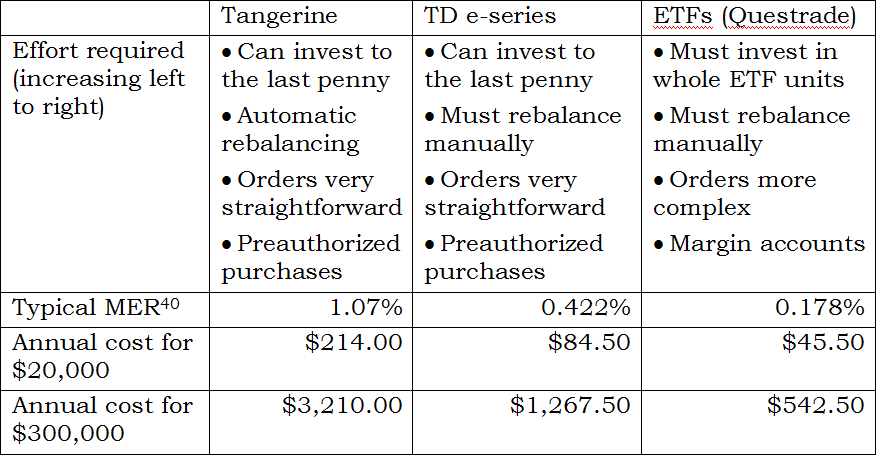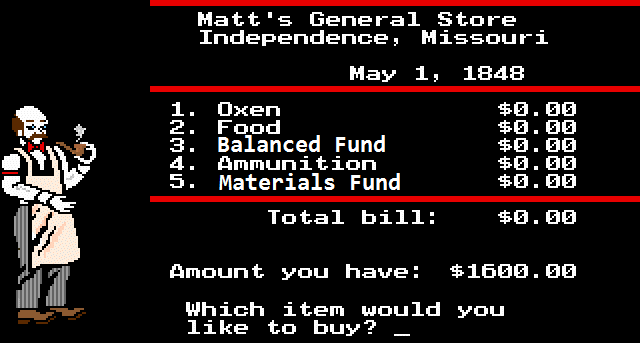Index Investing: Beyond the Three Options
October 29th, 2014 by PotatoI provided a table of three great options for index investing in The Value of Simple (excerpt in the last blog post). Why those three? Quite simply because they represent the best options available in the market, at various points of trading off cost and simplicity. Aside from paying an advisor to do it for you, nothing gets simpler than Tangerine’s single fund and super-simple website and tablet app. You don’t even have to call someone to set up a preauthorized purchase plan. Many fund companies have regular (no-load) mutual funds that track the main indexes, which will let you set up a good index portfolio with ~4 funds. However, rebalancing 4 funds is the level of difficultly that TD e-series sits at, and nothing is as cheap as that in the mutual fund game. Beyond mutual funds there are ETFs, which is where it gets as cheap as it possibly can, but at a significant step up in terms of difficultly. Questrade offers no-commission purchases, low commissions for sales, and accounts only have to have $5000 to avoid maintenance/inactivity fees.
Here’s a list of the other options, and why they didn’t make the book:
- BMO: Though BMO offers low-cost index funds traded on the stock exchange (ETFs), and in a quasi-Vanguard manner allows its mutual fund investors to invest in the same indexes, it does not manage to make the offering very attractive. Though you can buy in with as little as $50, the MER on their Canadian equity fund is 1.05% — barely a hair below Tangerine.
- CIBC: Index funds have high minimum purchase ($500) and high MERs — at 1.14% it’s higher than Tangerine’s.
- National Bank: Their index funds are moderately competitive, with MERs of just 0.66%. The funds are a little less diverse than I would like — the Canadian index tracks the TSX 60 rather than the full composite, and the US index tracks the Dow (30) rather than one of the larger indexes like the S&P500. The minimum initial investment is $500.
- PC Financial: It looks like PCF has recently updated their offerings to get closer to Tangerine. Their portfolios are marginally more expensive, and include more asset classes. Their “Balanced” fund, for example, has 50% fixed income, of which 5% (of the total fund) is in international bonds. The international equity component is split with separate European and Asia-Pacific indexes. Each fund “portfolio” has a slightly different MER; the balanced fund is 1.09%. Like their CIBC parent, they require $500 to invest at a time. PCF offers a 0.1% discount to the CIBC MER (it’s not clear from their website whether this is included in the MER listed), but this discount is distributed quarterly as extra units and counts as taxable income in non-registered accounts — a nightmare for bookkeeping in a non-registered account.
- RBC: Their index funds are not outrageous with MERs between TD’s e-series and Tangerine — but at 0.72% it’s still beaten by TD’s e-series.
- Scotiabank: The mutual funds arm of Scotia has high initial investment requirements ($1000) and with an MER of 1.00% on their Canadian Index fund they are not competitive with TD — it’s barely better than the simpler Tangerine.
- Scotia iTrade: Scotia’s discount brokerage arm was one of the first to come out with commission-free ETFs (mere weeks after the release of the first book, I might add). However, only a select list of ETFs are available, and none of them are the mainline ultra-low-cost broad indexes. You can build a decent portfolio from their offerings (e.g. to follow the broad TSX composite you would buy both HTX for the TSX 60, and XMD to cover the rest), but the average MER will be closer to ~0.3%, at which point TD’s e-series don’t look so bad, or for large accounts even paying the commission for XIC will put you ahead of using the list of free-to-purchase ETFs.
- QTrade: (Different from Questrade) has some commission-free ETFs; basically the same list as Scotia iTrade.
- Virtual Brokers: Very competitive with no-commission ETF purchases, but require $15,000 minimum account to avoid fees. This was basically a coin-flip as to whether I wanted to include it or not, and in the end I didn’t see anything from VB that Questrade wasn’t already offering, so I kept the line-up as simple as I could.
I was a little hesitant at first to recommend specific companies, but the fact is that they offer indisputable advantages for the reader, and giving detailed step-by-step instructions is only feasible with a few definite options.
For the average investor, a low-cost index investing approach is the easiest and simplest method available, and also provides the highest chances of long-term success. While there is a lot of material available on why investors should choose passive approaches over high-fee active mutual funds and what passive investing products exist, the average investor is at a loss on how to implement a passive index investing plan. The Value of Simple: A Practical Guide to Taking the Complexity Out of Investing provides a plain-language explanation of how Canadians can implement a low-cost index investing strategy, with step-by-step instructions and a focus on developing good investing processes. Coming December 1st.




 Questrade: use QPass 356624159378948
Questrade: use QPass 356624159378948 Passiv is a tool that can connect to your Questrade account and make it easier to track and rebalance your portfolio, including the ability to make one-click trades.
Passiv is a tool that can connect to your Questrade account and make it easier to track and rebalance your portfolio, including the ability to make one-click trades.